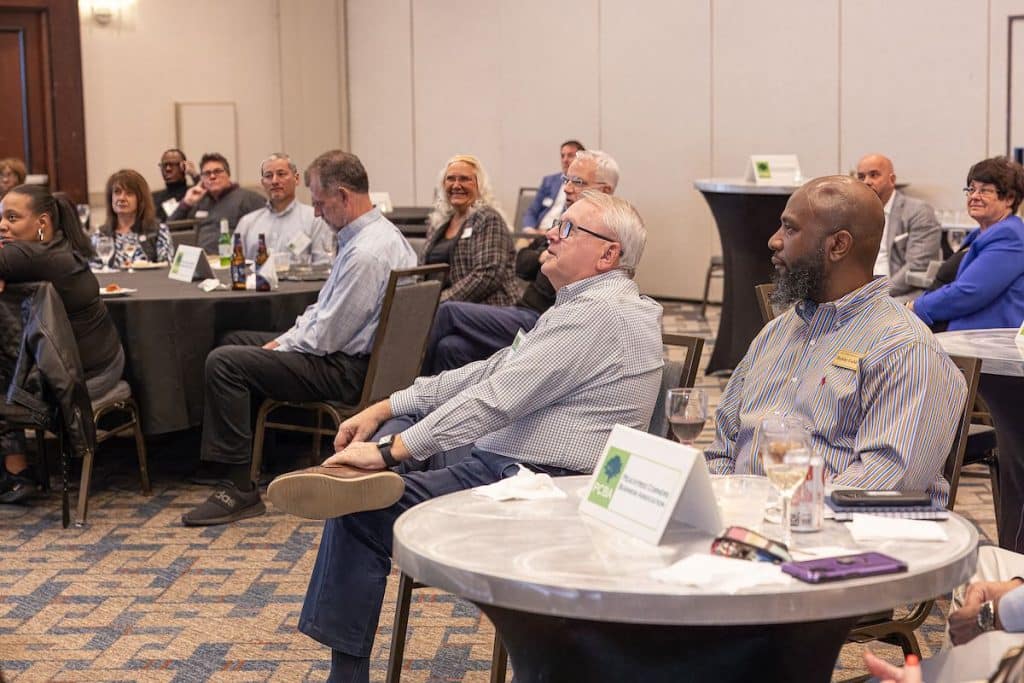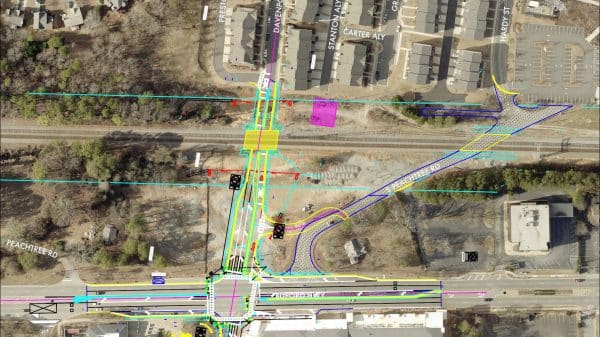With so many big rigs on roads these days, moving goods across the country and throughout the region, one might think that trucking companies are rolling in cash.
As the owner of a mid-sized trucking operation, Kathryn Stewart recently spoke to members of the Peachtree Corners Business Association about the volatility of the industry. She also described how, as a woman-owned business in a male-dominated field, she’s learned to navigate the terrain, whether it’s on cruise control or a bumpy ride.
Having been in business for 30 years, Performance Trucking provides local, regional and long-haul freight capacity with specialty services to meet various customers’ needs.
Stewart’s husband and daughter started the company in 1993. About five years ago, she took over half the ownership. Her husband retired about a year and a half ago; now, she is the owner and CEO.
The company is large enough to be sustainable, with 110 semi-trucks and 275 trailers based out of Lawrenceville and a second terminal in Lakeland, Florida. Yet, there is still competition from huge companies with over 1,000 trucks.
“We have so much volatility, and we constantly have to bend, change, adjust and adapt to changing inputs in our economy,” Stewart said.

Challenges in the trucking industry
As with any industry, trucking is cyclical.
“We go in phases … [many] where [transportation] rates will go down. Trucking companies that can’t compete … exit the industry,” Stewart said. “Most recently, 2019 was a bad year for trucking.”
She explained that COVID-19 made everyone, especially drivers, nervous.
“We were afraid that one driver could catch COVID, and we would not be able to go into any facilities and be isolated,” she said. “It would isolate the whole company along with the drivers.”
Also, during the pandemic, trucking was in high demand.
“Drivers were in high demand, and it was profitable. So, we’ve had a few very good years, 2021 and 2022,” said Stewart.
The promise of big paydays drew more people into the industry, which eventually saturated the market.
“The profit margin is low, but in trucking, you can buy a truck if you have good credit and a down payment. You don’t have to have a college degree or anything, and you can enter the market with relative ease,” said Stewart.
“So, people did jump into the market with their trucks and increased the numbers. Then, the economy slowed. COVID weighed things down, and we’ve got too many trucks in the market,” she explained.

The peaks and valleys of entrepreneurship
As the rules of supply and demand dictate, when there are fewer resources, prices go up, and when there are too many, prices go down.
“What’s happening now is the rates are being pushed down from jobs, which is expected, but our inputs have not gone down,” she said. “So even when people are forcing the rates down, we’re not able to push back easily because the customers control the rates more than drivers.”
“When the economy grows, trucking needs increase in price, and it gets more complex,” said Stewart.
She explained that personnel is the biggest expense, like in most businesses. For her, it’s drivers.
“During COVID times, we had to attract drivers. They were fearful, just like we were, of leaving the house. They were afraid of exposure. Yet, they were out on the front lines all the time,” she said.
“While we could shelter at home, they were on the front line and moving right ahead. It became very apparent to all of us during that time, how important trucking and drivers were,” Stewart stated.
So important, in fact, that they demanded higher pay.
“We needed people. ‘Butts in seats’ is how they referred to it, so we increased the pay rate to entice drivers to come. … Once you go up, you can’t really go down on rates with employees or with drivers. So, we still have that continuing high rate of pay for drivers,” said Stewart.

Keeping trucks rolling
The second biggest expense that’s much more difficult to control is the cost of fuel.
“We all watch the fuel prices at the pump. … We get happy when [the price] goes down, and we get stressed when it goes up. But it affects our bottom line all the time at home,” said Stewart.
In the trucking sector, there are different ways of providing rates to customers, explained Stewart.
“We have what’s called a line haul rate, which doesn’t fluctuate. It stays steady through a contracted period,” she said. “Then, on top of that, you have a fuel surcharge which ebbs and flows with the cost of fuel. So, we get to add that onto our line haul rates.”
However, customers have a scale they control based on the Department of Energy fuel average. It’s released every week, so it can fluctuate greatly.
“We can handle some of the ebbs and flows of changes in fuel, but we don’t get the whole benefit. It’s not for dollar for dollar,” she said. “They have lower charts than we would pay at the pump.”
Subsequently, the cost of doing business includes absorbing spikes in fuel costs.
“Some of our customers are actually paying 10¢ lower [than the actual increase], so we’re paying around 20¢ or more per gallon than what we pay at the pump,” she explained. “That’s an input we can’t really influence as a medium-sized company. I think larger companies could have more input, but we do not have that capacity.”

Staying on course
With all the rising insurance rates, driver shortages, competition and more issues, Stewart still strives to keep up with the industry, grow her business and be a good boss.
“We have long-term employees, and we try to keep them happy. We’re family-oriented,” said Stewart.
“Drivers text me on my personal cell phone. So, we try to keep that approachable and reachable,” she added.
We really do care about every driver and every person in the company. I think that matters. They stick with you and create an environment they’re comfortable in and don’t really feel the need to leave,” Stewart said.
















